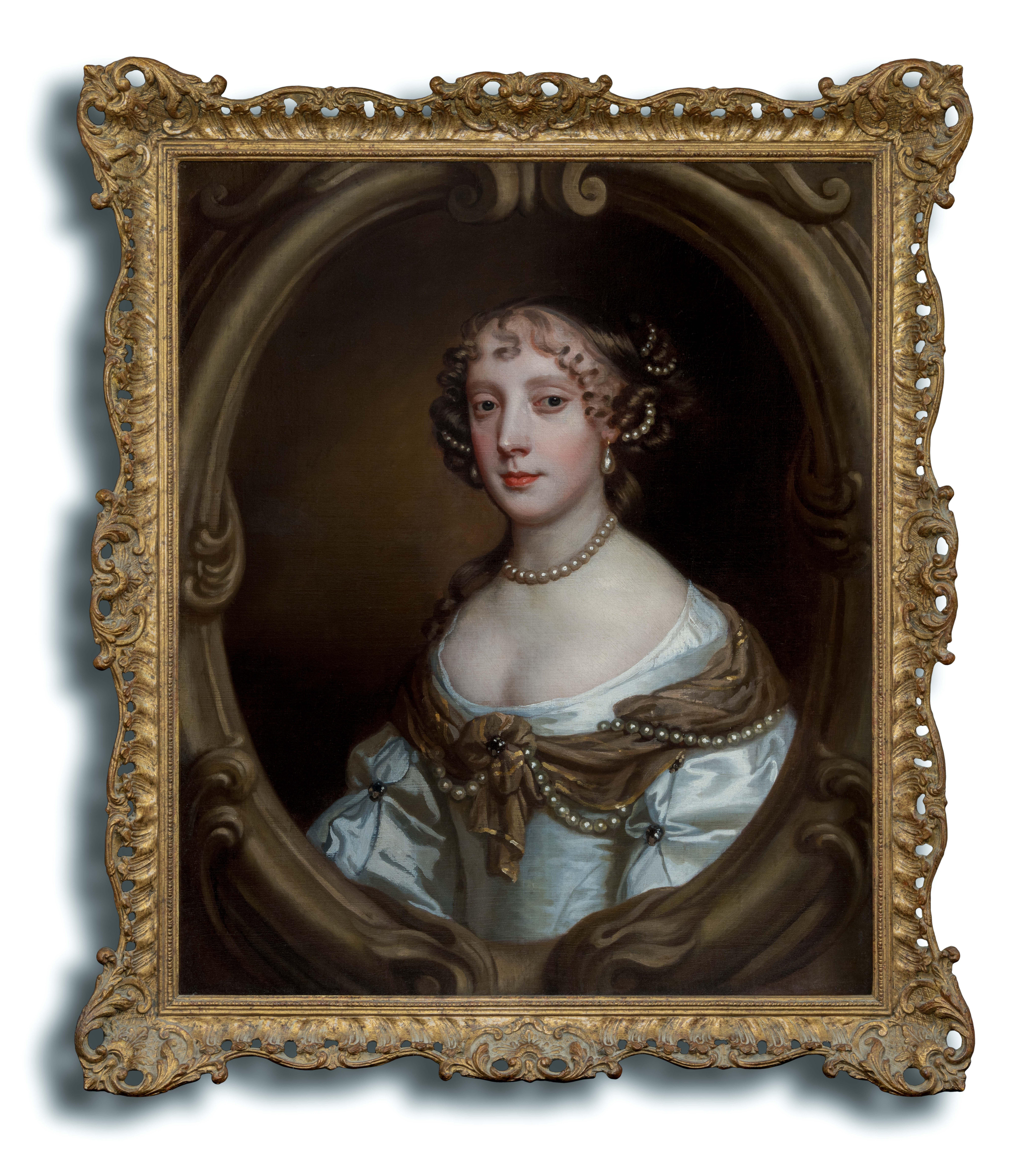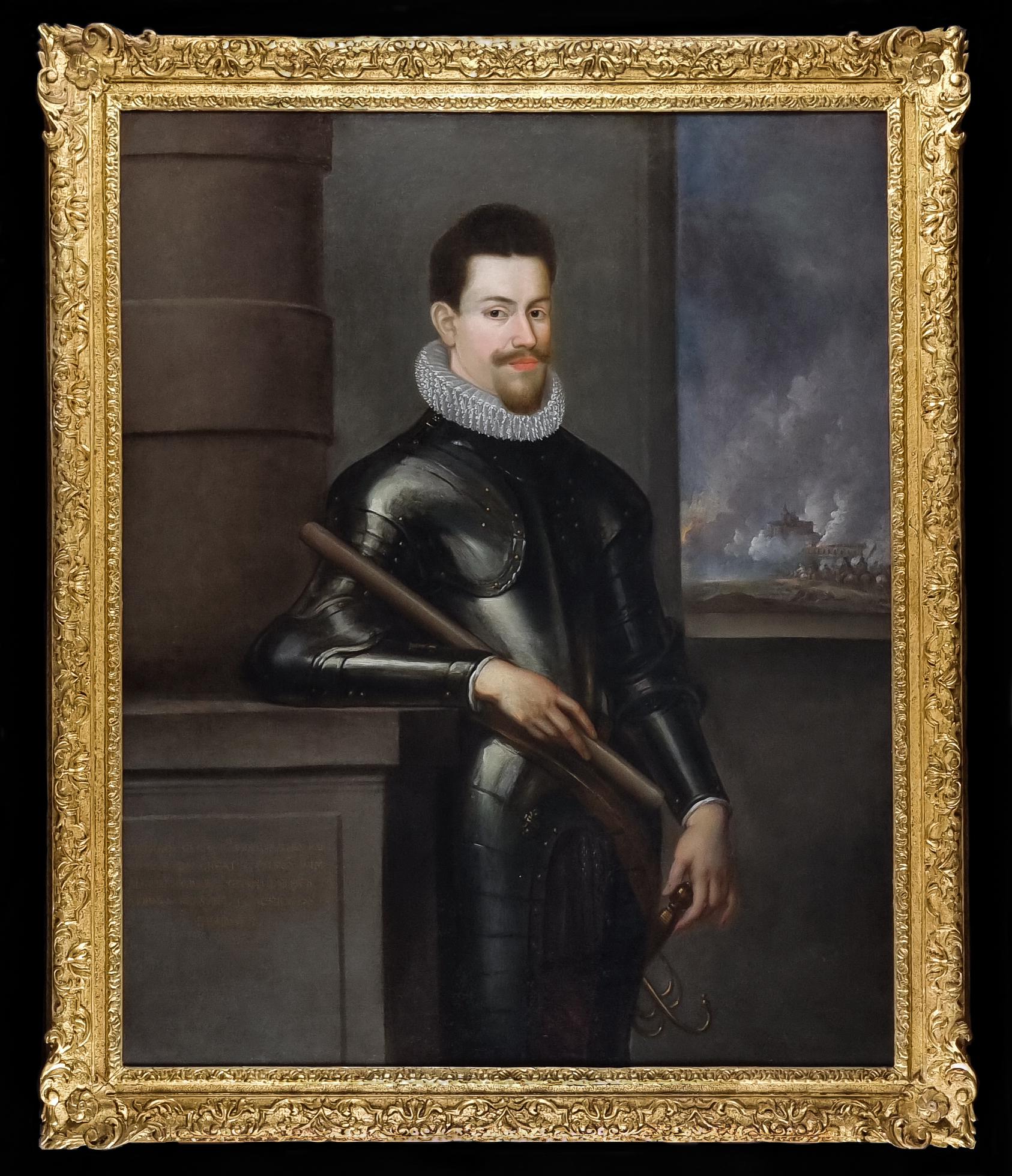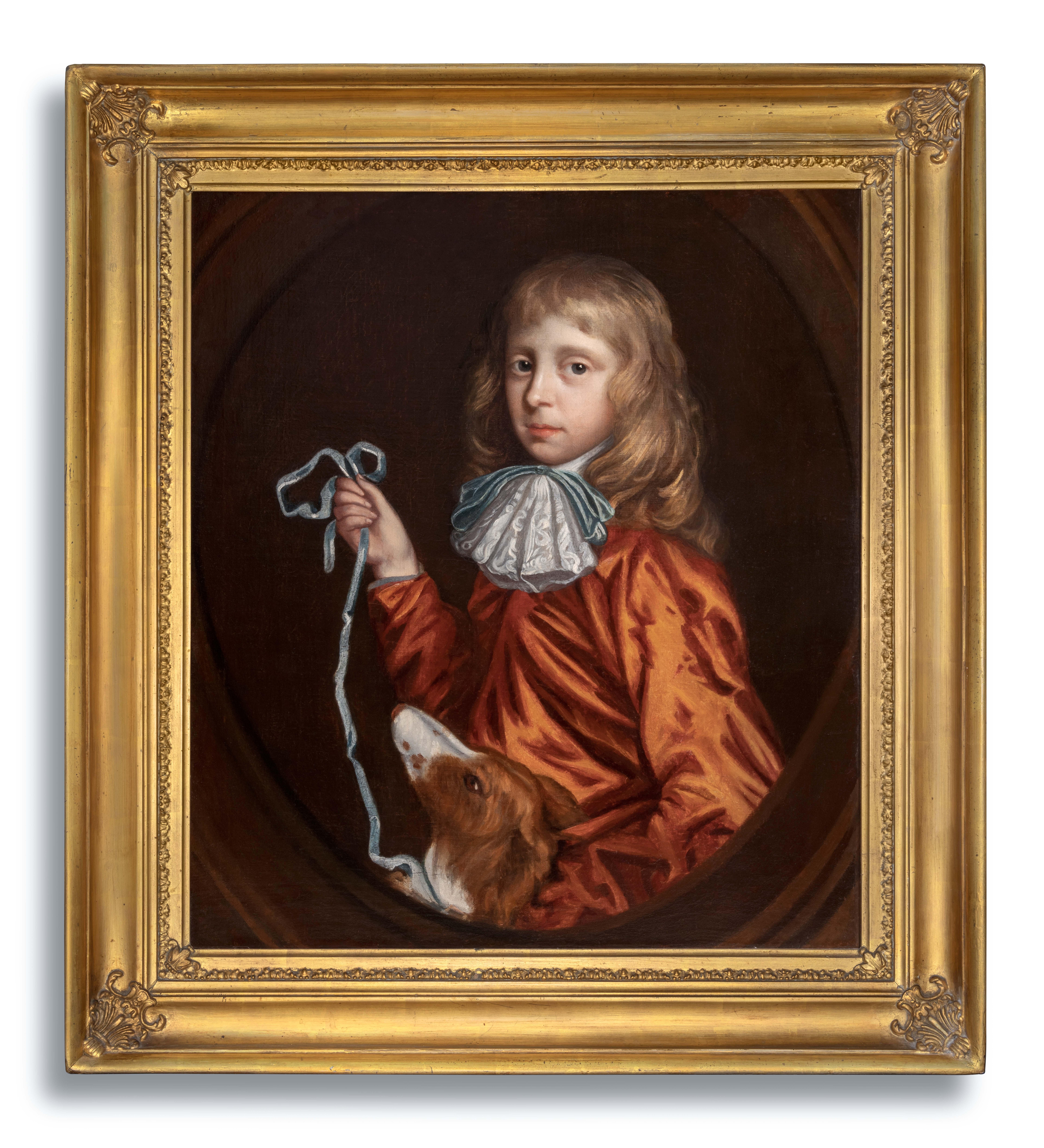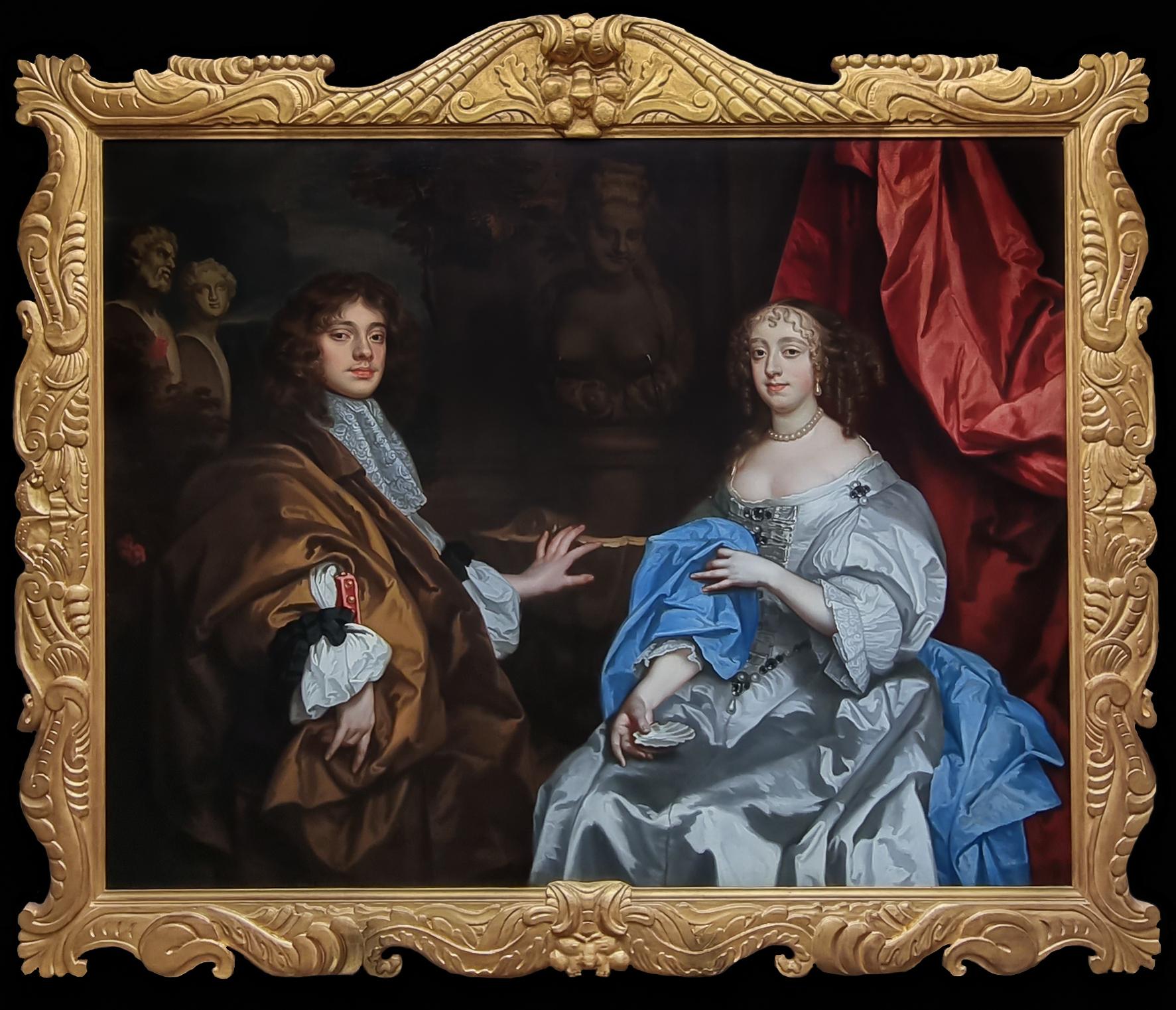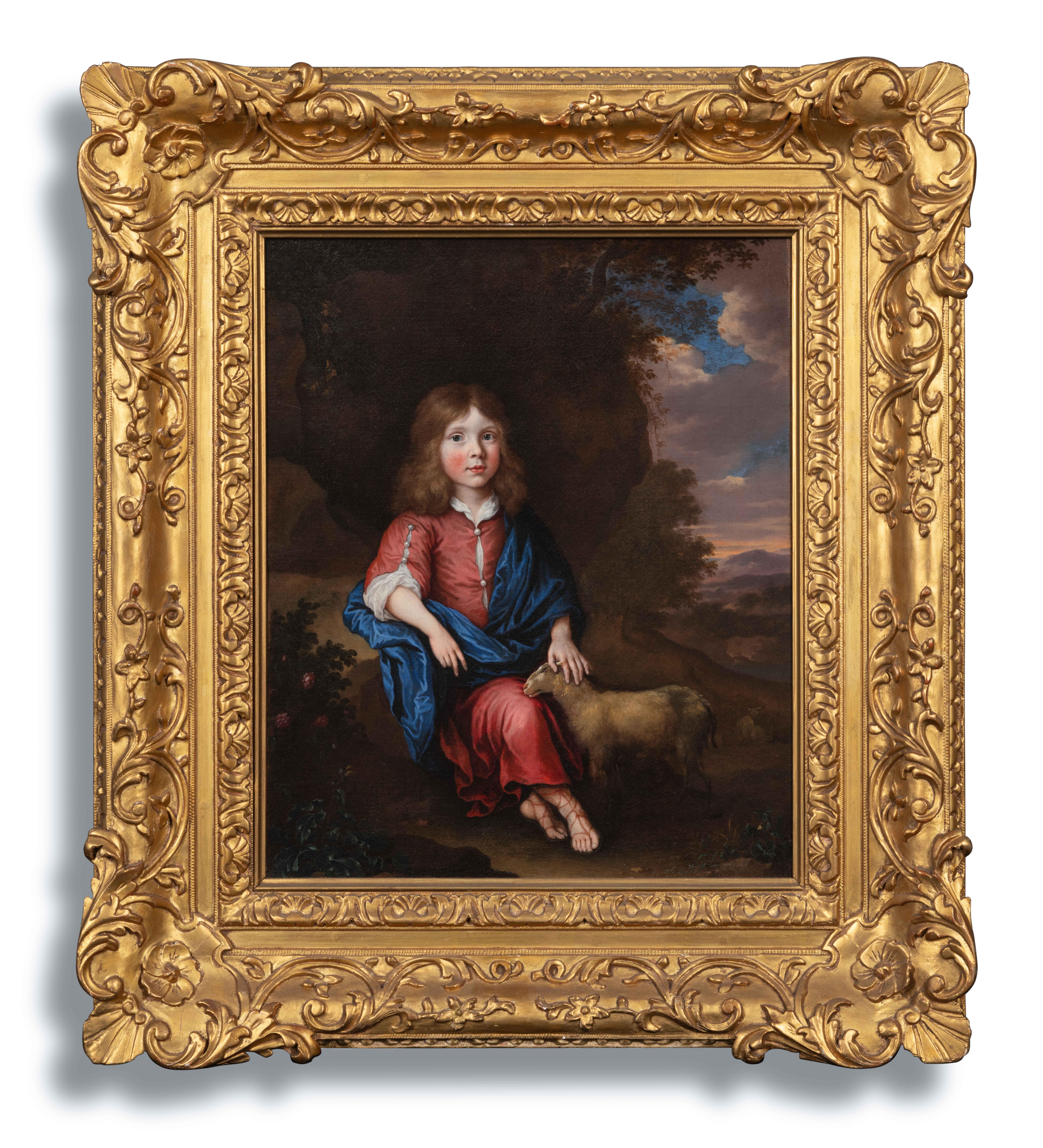Items Similar to Portrait of Frances Lady Whitmore nee Brooke, Exquisite Carved Frame, Old Master
Want more images or videos?
Request additional images or videos from the seller
Portrait of Frances Lady Whitmore nee Brooke, Exquisite Carved Frame, Old Master17th Century
17th Century
About the Item
Portrait of Frances, Lady Whitmore nee Brooke (c.1638-1690)
Circle of Sir Peter Lely (1618-1680)
Titan Fine Art presents this exquisite portrait that depicts Frances Brooke, Lady Whitmore when she was around twenty-five years of age. Depicted three-quarter length and seated in a woodland the portrait is an excellent example of English Baroque portraiture. The work was in the collection of Lieutenant-Colonel Godfrey Fitzhugh who was a descendant of the sitter at his magnificent family mansion, Plas Power Hall in Wales. The work is held in an outstanding carved giltwood frame with undulating sprays of bay leaves & berries, oak leaves and acorns, with roses, interrupted by acanthus leaf corners – an exquisite work of art in itself.
Our sitter was born Frances, Lady Brooke and was the daughter of Sir William Brooke; she was known as a great beauty at the Restoration court. The beautiful Brooke sisters, Frances and Elizabeth, were brought to London and taken to Court at an early age. Their grandfather was George Brooke, younger brother of Henry VIII’s Lord Cobham, and their uncle was Digby, Earl of Bristol. It is said that they were introduced to Court by their uncle, the Earl of Bristol, in the hope that one or both would capture the attention of the versatile Charles. Our sitter, Frances, escaped the temptations of the Court by espousing Sir Thomas Whitmore of Bridgnorth (c.1642-1682) sometime before May 1665; he was the second son of Sir Thomas Whitmore, 1st Baronet of Apley Park (1612-1653). The couple had three daughters, one of whom (Frances) was also a great beauty, married (secondly) Sir Richard Myddelton 3rd Baronet of Chirk Castle. Our sitter’s husband died in 1682 and was buried at St. Pauls Cathedral, London. Lady Whitmore then married Mathew Harvey, Esquire of Twickenham (c.1639-1693) as her second husband. He had both a brother and a cousin who were knighted and his uncle was the great physician who discovered the secret of the circulation of blood. It was said that there seemed to be a deep love between the couple. She died 15th May 1690 and was buried at Twickenham; her monument contains an epitaph by Dryden.
The inspiration for this portrait was a painting which forms part of a series of eleven portraits known as The Windsor Beauties painted by Sir Peter Lely and his workshop produced early to mid-1660s. They sitters depict ladies of the court of King Charles II; Frances Teresa Stuart was Maid of Honour in the Royal Household, some of the others were noted courtesans, while others were respected members of the nobility. The name stems from the original location of the collection, which was at Windsor Castle. They set show the women at three-quarter length in various poses. Some women wear current fashions; others are draped in fabric described by Lady Mary Wortley Montague as “a night-gown fastened with a single pin” (a night-down at the time is an evening dress today) as this style did not quickly ‘date’ the portrait and it was also intended to evoke classical antiquity. Originally commissioned, or assembled, by Anne Hyde, Duchess of York, when the set was first mentioned they were hung in "the Duke of York's room" in 1668 and at some time prior to 1835 they were transferred to Hampton Court where they were still on display as of 2022. As such was the notoriety of these woman there was a high demand for their portrait and Lely’s series were the subject of many replicas both at the same time and also into the next century. Our portrait is one such example and would have been painted during the lifetime of the sitter.
Our portrait was in the collection of Lieutenant-Colonel Godfrey Fitzhugh, Plas Power Hall near Wrexham. Wrexham was once surrounded by a whole ring of country houses of exceptional historical and architectural interest such as Acton Park, Cefn Park, Erddig Hall, Cadwgan Hall, Plas Power, Brymbo hall, Stansty Park, Gwersyllt Park, and Grewford Lodge of which most have now been demolished. Sir Henry Power appears to have established the estate in 1620. His grandson sold it to William Fownes in 1699, and in 1733 it was sold to Mary Myddelton, daughter of Sir Richard Myddelton of Chirk Castle. Plas Power was thereby added to the estates that Mary Myddelton had already inherited from her mother, Frances Whitmore, the sitter in our portrait. From 1720, the sitting tenant at Plas Power was Rev. Thomas Lloyd, whose mother was Elizabeth Myddelton of the Plas Cadwgan branch of the Chirk family; he had been tutor at Chirk under Richard Myddelton, served Mary Myddelton as chaplain, and also acted on behalf of both of them in estate matters throughout his life. On Thomas Lloyd's death in 1734, therefore, his son, William, succeeded him as the sitting tenant at Plas Power, and on Mary Myddelton's death in 1747 she bequeathed Plas Power to him, also making him a trustee of the Chirk estate. William Lloyd's second son, also named William, succeeded him at Plas Power, and on his death without issue in 1816 the estate passed to his nephew, Thomas FitzHugh (1770-1857). Plas Power then passed to his son Godfrey William Fitzhugh (1829-1895), to his son Capt. Godfrey Fitzhugh (1873-1917), and finally to his son, Col. Godfrey Edmund Fitzhugh (1905-1985).
Therefore close links between Plas Power and Chirk existed for many years. Our portrait, along with at least three other family portraits, were at Plas Power by 1906 (including portraits of our sitter’s three daughters by Godfrey Kneller).
Peter Lely, the son of a Dutch military officer, was born in Germany at Soest in Westphalia in 1618. He studied in Haarlem before moving to London in 1641, and in 1647 he became a freeman of the Painter-Stainers’ Company. Initially, Lely painted landscapes, religious, and mythological scenes, however, he quickly recognised the strength of the English market for portraiture and this is where he turned his attention. He was employed by the Duke of Northumberland, who had the royal children in his care, and he was able to study the Northumberland Collection of works by Van Dyke and Dobson. By the end of the Commonwealth he had become the best-known portraitist in England. In 1661 he was appointed Principal Painter to the King and from then on, he maintained a busy and successful practise painting the most elite and influential members of the court and of everyone of importance. His studio was prolific and employed many assistants, as was the common studio method. His success thus meant that he established the basic English portrait style for decades.
Lely was a connoisseur and was known for his own fine art collection. By the end of his life he had assembled one the finest non-princely collections in Europe including more than 25 of Van Dyke’s major English works of Old Masters including Veronese, Titian, Claude Lorrain and Rubens, and a fabulous collection of drawings, was broken up and sold after his death, raising the immense sum of £26,000. Some items in it which had been acquired by Lely from the Commonwealth dispersal of Charles I's art collections, such as the Lely Venus, were re-acquired by the Royal Collection.
Literature:
“Some beauties of the seventeenth century” by Allan Fea (1860-?), p.260, published 1906 by Methuen & Co., London
Provenance:
[Possibly] By descent in the family of Frances, Lady Myddleton, Chirk Castle, the sitter's daughter until the twentieth century;
Lieutenant-Colonel Godfrey Fitzhugh, Plas Power, Wrexham;
With Frost and Reed, 1953 (according to a label on the reverse)
Private UK collection since at least 1974
Measurements:
Height 150cm, Width 125cm framed (Height 59”, Width 49.25” framed)
- Creation Year:17th Century
- Dimensions:Height: 59.06 in (150 cm)Width: 49.22 in (125 cm)Depth: 2.37 in (6 cm)
- Medium:
- Movement & Style:
- Circle Of:Sir Peter Lely (1618 - 1680, Dutch)
- Period:
- Condition:This painting has passed a strict quality and condition assessment by a professional conservator prior to going on sale. It can be hung and enjoyed immediately.
- Gallery Location:London, GB
- Reference Number:1stDibs: LU1199114370432
About the Seller
5.0
Platinum Seller
These expertly vetted sellers are 1stDibs' most experienced sellers and are rated highest by our customers.
Established in 1998
1stDibs seller since 2019
31 sales on 1stDibs
Typical response time: <1 hour
- ShippingRetrieving quote...Ships From: London, United Kingdom
- Return PolicyA return for this item may be initiated within 14 days of delivery.
More From This SellerView All
- Portrait of Lady, Grace Saunderson, Viscountess Castleton Oil on canvas PaintingBy Studio of Sir Peter LelyLocated in London, GBPortrait of Grace Saunderson, Viscountess Castleton (1635-1667) c.1665-67 Sir Peter Lely and Studio (1618-1680) Titan Fine Art present this work, which formed part of a collection of family pictures and heirlooms of the Saunderson, Viscount Castleton family and their descendants, the Earls of Scarbrough, at their magnificent family seat Sandbeck Park, where the Earls still reside today almost four hundred years later. It was painted in the studio of Sir Peter Lely...Category
17th Century Old Masters Portrait Paintings
MaterialsCanvas, Oil
- Portrait of a Gentleman in Armour and Holding a Baton, Manor House ProvenenceLocated in London, GBTitan Fine Art present this accomplished work, from Kilcooley Abbey, Co Tipperary, Ireland. It portrays a gentleman traditionally known as the English military commander and politic...Category
17th Century Old Masters Portrait Paintings
MaterialsCanvas, Oil
- Portrait of a Young Gentleman and Pet Dog c.1680, Antique oil on Canvas PaintingBy (Circle of) Mary BealeLocated in London, GBThe portrait genre was valued particularly highly in English society. Neither landscapes nor allegorical pictures were ever priced so highly at exhibitions and in the trade as depictions of people, from the highest aristocracy to scholars, writers, poets and statesmen. This charming portrait, presented by Titan Fine Art, of a fashionable young gentleman and his faithful pet is an excellent example of 17th century child portraiture in England. There is a remarkable beauty and sensitivity to the portrait. The face, particularly well rendered, has captured the character of this young man – both charming and at the same time mischievous. Only the playful attention of a small dog suggests anything less than patrician dignity. Symbolism was important in portraiture and it provided a pointed and aspirational narrative that would not have been lost on contemporary viewers. For example, the presence of the dog, which was likely the boy’s pet, is at once a charming pictorial device and also a clear allusion to fidelity, trust and loyalty. The hairstyle and the attire, notably the type of cravat with the blue ribbon, help to date this portrait to between 1670 to 1685. Until the late eighteenth century children were dressed as adults - boys were dressed like men in breeches, vests, and coats between four and seven years of age. The expensive lace is an indication to his family’s wealth. Held in a good quality and condition antique gilded frame. Born in Suffolk, Mary Beale, nee Cradock (1633-1699) was employed by many of the most distinguished persons of her time including nobility, landed gentry, and clergymen. Technically accomplished, her paintings are noteworthy for their honest and sympathetic portrayal. In 1651 she married Charles Beale...Category
17th Century Old Masters Portrait Paintings
MaterialsCanvas, Oil
- Portrait of Abigail, Countess of Kinnoull, Signed Dated Godfrey Kneller PaintingBy Kneller GodfreyLocated in London, GBPresented by Titan Fine Art, this elegant and beautiful portrait depicts Abigail Hay, Lady Dupplin, Countess of Kinnoull; it is an excellent example of English portraiture from the f...Category
18th Century Old Masters Portrait Paintings
MaterialsCanvas, Oil
- Double Portrait of Sir John Rivers 3rd Baronet of Chafford, and Lady Anne RiversLocated in London, GBThis magnificent grand-scale work, offered by Titan Fine Art, formed part of a collection of family pictures and heirlooms of the Rivers Baronets and their descendants for over 325 years, before it was dispersed by the last in the line in 1988. The work was painted by the most technically proficient painter in England after the death of Van Dyck, and the dominant court painter to Charles II and James, Duke of York, Sir Peter Lely. It is no surprise that for years Lely had no serious rivals, was enormously influential and successful, and one of the country’s most important painters – and his work influenced countless artists over generations. The exquisite carved and gilded auricular frame is an astounding work of art in itself. The sitters in this exquisite double portrait are Sir John Rivers, who succeeded as the 3rd Baronet Chafford in 1657 (c.1638 - c. 1679), and his wife, Lady Anne Hewitt (c.1640-c.1689). They are seated in an outdoor setting beside a fountain modelled as a female figure with water issuing into a scallop-shell. The water, the elaborate sculpted fountain with its scallop-edged bowl, and the open shell in her hand are symbols of fertility - as such they make an appropriate allusion to Lady Anne’s potential as wife and mother, recalling Proverbs, chapter 5, verse 18: “Let thye fountain be blessed, and rejoice in the wife of thye youth”. This reference was realised, as Sir John and Lady Anne produced at least six children; their son George (1665-1734) became 4th Baronet of Chafford. The composition, thus, represents a celebration of marriage and was likely commissioned around the time of the betrothal (the marriage took place 26th Feb 1662 or 1663). The statues in the left margin are 'Youth and 'Old Age' and are a typical form of Memento Mori reminding virile young man that even they will lose their youth and grow old. The Rivers family, originally of Kent, traces its history to Sir Bartholomew Rivers, in the reign of Edward IV. The family included several prominent members including several knights, a Commander in the King's Army, a steward of a ducal estate, a Lord-Mayor of London, and an M.P. John Rivers (c.1659-c.1651) was made 1st Baronet of Chafford in 1622 by King James I. The Chafford estate was the family seat and it remained so until the early 1700s with the death of Sir George Rivers, 4th Baronet (1665–1734), whose sons had all died. The Chafford estate was left to his daughters while the baronetcy passed to nephew John Rivers, 5th Baronet (c. 1718–1743), and then Sir John’s brother, Sir Peter Rivers-Gay, 6th Baronet (c. 1721–1790). Upon Sir Peter Rivers Gay's death the estate passed to his eldest son, Sir Thomas Rivers Gay, 7th Baronet (c. 1770–1805). Sir Thomas, dying in 1805 with no children, bequeathed the estate to his mother Dame Martha Rivers Gay, who managed the estate until 1834 when she settled it on the then Sir Henry Rivers, 9th Baronet (c. 1779–1851) her younger son, before dying shortly thereafter in 1835. Sir Henry had married in 1812 to Charlotte Eales, with whom he had 6 sons and 8 daughters. Upon his death in 1851 the estate passed to his eldest surviving son Sir James Francis Rivers, 10th Baronet (1822–1869). Sir James married Catherine Eastcott in 1867 but died childless in 1869, and the estate passed to his only surviving brother Sir Henry Chandos Rivers, 11th Baronet (1834–1870) but he died a year later in 1870 also childless; with no male heir the Baronetcy was therefore extinguished. The estate was bequeathed, in trust, by Sir Henry Chandos Rivers to Thomas Frederick Inman, a solicitor of Bath, who then managed the estate as a trustee on behalf of Sir Henry Chandos Rivers' sister Katherine Rivers (c.1826-1895). It then passed to Katherine River’s daughter, Katherine Wall (born c.1855), who had also inherited Worthy Park House from her father, George Alfred Ellis Wall (1825-1875). Until 1958 our portrait is known to have hung at Worthy Park House. Upon Katherine Wall’s death, the Rivers estate passed to her daughter, Katherine Eleonora Rivers Fryer (1889-1963), who married Colonel James Alexander Butchart 1877-1853. In 1958 the family sold Worthy Park House but our portrait was loaned to Southampton Museum and Art Gallery. After the death of Katherine and Colonel James, the estate was left to their only son, Charles Bruce Rivers Butchart (1917-2005) and upon Charles’ retirement to a nursing home in 1988, and without heirs, our portrait, along with the residual assets of the Rivers estate were sold, thus ending over 325 years of continual family ownership. Lady Anne Rivers is thought to have been born circa 1640. She was the fourth child of the second marriage of Sir Thomas Hewitt (or Hewett) (1606-1662), 1st Baronet of Pishobury, Herts, and his wife Margaret Lytton (died 1689). Sir Thomas was an English landowner and M.P. for Windsor and upon the English Restoration...Category
17th Century Old Masters Portrait Paintings
MaterialsCanvas, Oil
- Portrait of a Young Gentleman, Pieter Van Der Dvssen; by Jan van HaensbergenBy Jan Van HaensbergenLocated in London, GBPortrait of a Young Gentleman, Pieter Van Der Dvssen c.1664 Jan van Haensbergen (1642–1705) This charming portrait is an excellent example of late 17th century child portraiture and is from one of the most prolific periods in art history – the Dutch Golden Age. A vast number of artists produced work to fulfil the demands and tastes of a broad Dutch society, and many cities in the Netherlands developed into distinct artistic centres, characterised by style and specialities of subject. The quality of our portrait is similar to the works of the highly specialised ‘fijnschilders’, who were working in Leiden at the time; these artists executed meticulous small-scale paintings. As with the artist’s other works of children, Haensbergen painstakingly recorded many details including a fine depiction of the face, and the surface effects of the materials and the pearl clasps. The young sitter is Walther Bernt Pieter Van der Dussen. He was born into a wealthy noble Catholic family in Delft in 1654. In this portrait he would be around ten years of age, dating the work to circa 1664, which is also the year before the artist’s marriage to Johanna van Heusden. The Van der Dussen family were great patrons of the arts and commissioned a number of major works from eminent artists in Delft & Amsterdam. Van der Dussen died in 1716. The wooded setting, the lamb, and the “picturesque” or “Roman” dress...Category
17th Century Old Masters Portrait Paintings
MaterialsCanvas, Oil
You May Also Like
- Oil Portrait of a Victorian Lady, c. 1850Located in Chicago, ILPainted in the 19th century, this exquisite miniature portrait wonderfully exemplifies realism in traditional oil painting. The small artwork is painted in the conventional portraiture style of the Old Masters, and achieves soft realism with fine brushwork and a subdued, neutral palette. The half length portrait depicts a fine Victorian woman dressed in all black with a delicate lace collar and bonnet. She wears a ruby broach...Category
Mid-19th Century Old Masters More Art
MaterialsOil
- Henry Pickering, Portrait of a GentlemanBy Henry PickeringLocated in London, GBHenry Pickering, Portrait of a Gentleman Oil on canvas; signed and dated 1759; held in a giltwood period frame Provenance: Lenygon & Morant Ltd. c.1900; Knoedler, October 1912 (Sto...Category
Mid-18th Century Old Masters Portrait Paintings
MaterialsOil
- Charles Jervas, Portrait of Joseph MellishBy Charles JervasLocated in London, GBCharles Jervas (1675-1739) Portrait of Joseph Mellish (1675-1733) Oil on canvas; held in a carved period frame Dimensions refer to size of frame. Provenance: Blyth Hall, Nottinghamshire, England; by descent to Sir Andrew Buchanan of Hodsock Priory, Nottinghamshire In 1635 John Mellish, a merchant tailor of London, bought the estate of Blyth in Nottinghamshire. His son, a wealthy Oporto merchant, dying unmarried, left Blyth in 1703 to a cousin, Joseph Mellish, who became one of Newcastle’s earliest and most important political supporters in the county. He went up to Clare College, Cambridge in 1692 and on to the Inner Temple the following year. He married Dorothea Gore, daughter of Sir William Gore...Category
Early 18th Century Old Masters Portrait Paintings
MaterialsOil
- "Army of Snorkelers" - Mirrored Female Swimmer Portrait PaintingLocated in West Hollywood, CAThis large horizontal 37 inch high and 76 inch wide original oil painting on canvas is wired and ready to hang. The detail in this artwork is astounding. The crimson red tones make t...Category
2010s Contemporary Portrait Paintings
MaterialsCanvas, Oil
- "The Shining 2" - Colorful Female Figurative Swimmer Portrait PaintingLocated in West Hollywood, CAThis 36 inch square original oil painting on canvas is wired and ready to hang. The detail in this artwork is astounding. The crimson red tones make the female swimmers portrait real...Category
2010s Contemporary Portrait Paintings
MaterialsCanvas, Oil
- European Portrait of a PriestLocated in Milford, NHA fine European portrait of a priest, oil on canvas, probably dating to the 17th or 18th century, unsigned, with original stretcher, minor surface losses and damage, craquelure, edge...Category
17th Century Portrait Paintings
MaterialsOil, Canvas
